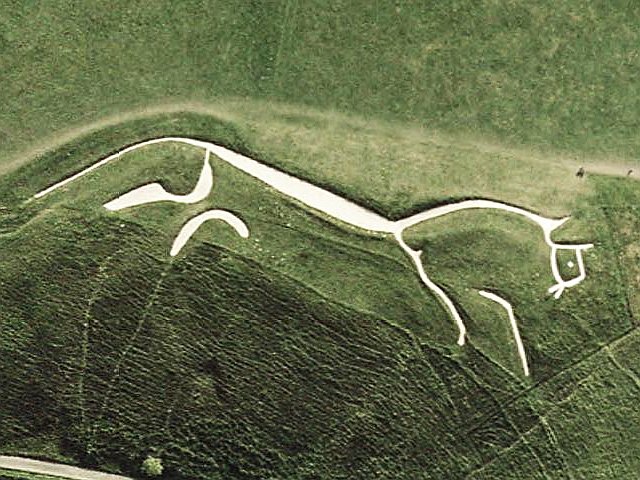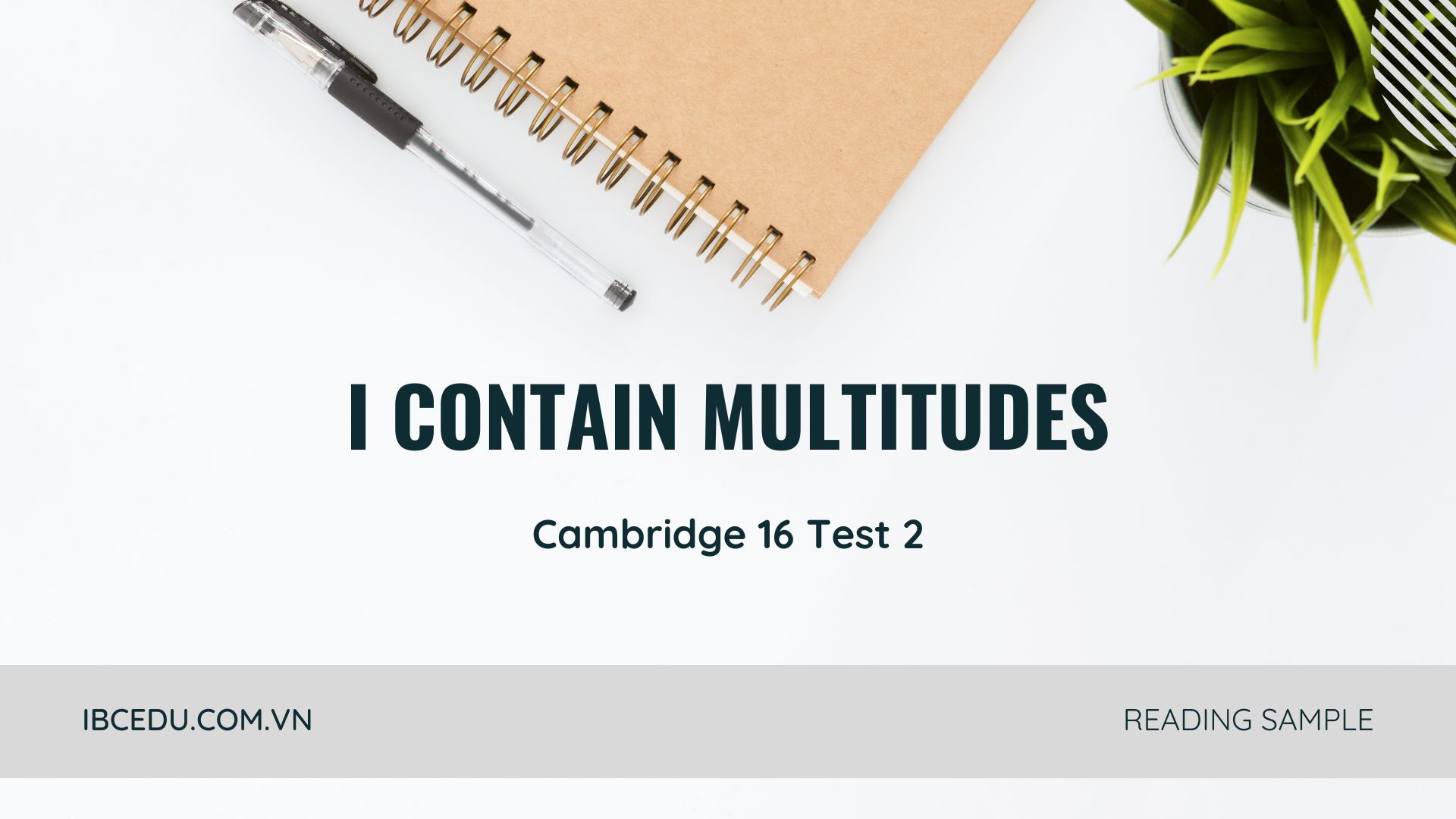THE WHITE HORSE OF UFFINGTON

The cutting of huge figures or ‘geoglyphs’ into the earth of English hillsides has taken place for more than 3,000 years. (Q1) There are 56 hill figures scattered around England, with the vast majority on the chalk downlands of the country’s southern counties. (Q2) The figures include giants, horses, crosses and regimental badges.Although the majority of these geoglyphs date within the last 300 years or so, there are one or two that are much older.
The most famous of these figures is perhaps also the most mysterious — the Uffington White Horse in Oxfordshire. (Q3) The White Horse has recently been re-dated and shown to be even older than its previously assigned ancient pre-Roman Iron Age date.(Q4) More controversial is the date of the enigmatic Long Man of Wilmington in Sussex.While many historians are convinced the figure is prehistoric, others believe that it was the work of an artistic monk from a nearby priory and was created between the 11th and 15th centuries.
(Q5) The method of cutting these huge figures was simply to remove the overlying grass to reveal the gleaming white chalk below. However, the grass would soon grow over the geoglyph again unless it was regularly cleaned or scoured by a fairly large team of people. (Q6) One reason that the vast majority of hill figures have disappeared is that when the traditions associated with the figures faded, people no longer bothered or remembered to clear away the grass to expose the chalk outline. (Q7) Furthermore, over hundreds of years the outlines would sometimes change due to people not always cutting in exactly the same place, thus creating a different shape to the original geoglyph.The fact that any ancient hill figures survive at all in England today is testament to the strength and continuity of local customs and beliefs which, in one case at least, must stretch back over millennia.
The Uffington White Horse is a unique, stylised representation of a horse consisting of a long, sleek back, thin disjointed legs, a streaming tail, and a bird-like beaked head. The elegant creature almost melts into the landscape. (Q9) The horse is situated 2.5 km from Uffington village on a steep slope close to the Late Bronze Age (c. 7th century BCE) hillfort of Uffington Castle and below the Ridgeway, a long-distance Neolithic track.
The Uffington Horse is also surrounded by Bronze Age burial mounds. It is not far from the Bronze Age cemetery of Lambourn Seven Barrows, which consists of more than 30 well-preserved burial mounds. The carving has been placed in such a way as to make it extremely difficult to see from close quarters, and like many geoglyphs is best appreciated from the air. Nevertheless, there are certain areas of the Vale of the White Horse, the valley containing and named after the enigmatic creature, from which an adequate impression may be gained. Indeed on a clear day the carving can be seen from up to 30 km away.
(Q10) The earliest evidence of a horse at Uffington is from the 1070s CE when ‘White Horse Hill’ is mentioned in documents from the nearby Abbey of Abingdon, and the first reference to the horse itself is soon after, in 1190 CE. However, the carving is believed to date back much further than that. Due to the similarity of the Uffington White Horse to the stylised depictions of horses on 1st century BCE coins, it had been thought that the creature must also date to that period.
(Q11) However, in 1995 Optically Stimulated Luminescence (OSL) testing was carried out by the Oxford Archaeological Unit on soil from two of the lower layers of the horse’s body, and from another cut near the base. The result was a date for the horse’s construction somewhere between 1400 and 600 BCE — in other words, it had a Late Bronze Age or Early Iron Age origin.
The latter end of this date range would tie the carving of the horse in with occupation of the nearby Uffington hillfort, indicating that it may represent a tribal emblem marking the land of the inhabitants of the hillfort. Alternatively, the carving may have been carried out during a Bronze or Iron Age ritual. (Q12) Some researchers see the horse as representing the Celtic horse goddess Epona, who was worshipped as a protector of horses, and for her associations with fertility. However, the cult of Epona was not imported from Gaul (France) until around the first century CE. This date is at least six centuries after the Uffington Horse was probably carved. Nevertheless, the horse had great ritual and economic significance during the Bronze and Iron Ages, as attested by its depictions on jewellery and other metal objects. (Q13) It is possible that the carving represents a goddess in native mythology, such as Rhiannon, described in later Welsh mythology as a beautiful woman dressed in gold and riding a white horse.
The fact that geoglyphs can disappear easily, along with their associated rituals and meaning, indicates that they were never intended to be anything more than temporary gestures. But this does not lessen their importance. These giant carvings are a fascinating glimpse into the minds of their creators and how they viewed the landscape in which they lived.
Questions 1—8
Do the following statements agree with the information given in Reading Passage 1?
In boxes 1—8 on your answer sheet, write
TRUE if the statement agrees with the information
FALSE if the statement contradicts the information
NOT GIVEN if there is no information on this
-
Most geoglyphs in England are located in a particular area of the country.
-
There are more geoglyphs in the shape of a horse than any other creature.
-
A recent dating of the Uffington White Horse indicates that people were mistaken about its age.
-
Historians have come to an agreement about the origins of the Long Man of Wilmington.
-
Geoglyphs were created by people placing white chalk on the hillsides.
-
Many geoglyphs in England are no longer visible.
-
The shape of some geoglyphs has been altered over time.
-
The fame of the Uffington White Horse is due to its size.
Question 1
Đáp án: True
Vị trí: Đoạn 1, câu 2.
Giải thích đáp án:
| Most geoglyphs in England are located in a particular area of the country | There are 56 hill figures scattered around England, with the vast majority on the chalk downlands of the country’s southern counties. |
| Giải thích | Câu 2 của đoạn 1 chỉ ra rằng có 56 ngọn đồi nằm rải rác trên khắp nước Anh, với phần lớn nằm trên vùng đất trũng bằng phấn của các quận phía nam của đất nước. Thông tin này khẳng định câu hỏi 1. Hầu hết các geoglyph ở Anh đều nằm trong một khu vực cụ thể của đất nước. |
Question 2
Đáp án: Not given
Vị trí: Đoạn 1, câu 3.
| There are more geoglyphs in the shape of a horse than any other creature. | The figures include giants, horses, crosses and regimental badges |
| Giải thích đáp án | Câu 3 của đoạn 1 chỉ ra rằng các hình ảnh bao gồm người khổng lồ, ngựa, thánh giá và huy hiệu trung đoàn. Thông tin trong câu hỏi 2. có nhiều geoglyph ở hình dạng ngựa hơn con vật khác, không được tìm thấy trong bài đọc. |
Question 3
Đáp án: True
Vị trí: Đoạn 2, câu 2.
| A recent dating of the Uffington White Horse indicates that people were mistaken about its age. | The White Horse has recently been re-dated and shown to be even older than its previously assigned ancient pre-Roman Iron Age* date. |
| Giải thích đáp án | Câu 2 của đoạn 2 chỉ ra rằng con ngựa Trắng gần đây đã được xác định lại niên đại và thậm chí còn cũ hơn so với niên đại thời kỳ đồ sắt tiền La Mã * cổ đại được ấn định trước đó của nó.
➱ Thông tin này khẳng định câu hỏi 3. Một niên đại gần đây của Ngựa trắng Uffington chỉ ra rằng mọi người đã nhầm lẫn về tuổi của nó. |
Question 4
Đáp án: False
Vị trí: Đoạn 2, 2 câu cuối.
| Historians have come to an agreement about the origins of the Long Man of Wilmington. | More controversial is the date of the enigmatic Long Man of Wilmington in Sussex. While many historians are convinced the figure is prehistoric, others believe that it was the work of an artistic monk from a nearby priory and was created between the 11th and 15th centuries. |
| Giải thích đáp án | Ở đoạn 2, 2 câu cuối chỉ ra rằng gây tranh cãi hơn là niên đại của Long Man bí ẩn của Wilmington ở Sussex. Trong khi nhiều nhà sử học tin rằng hình vẽ này có từ thời tiền sử, những người khác lại tin rằng đó là tác phẩm của một nhà sư nghệ thuật từ một tu viện gần đó và được tạo ra giữa thế kỷ 11 và 15.
➱ Thông tin này phủ nhận câu hỏi 4. Các nhà sử học đồng ý về nguồn gốc của Longman ở Wilmington. |
Question 5
Đáp án: False
Vị trí: Đoạn 3, câu đầu tiên.
| Geoglyphs were created by people placing white chalk on the hillsides. | The method of cutting these huge figures was simply to remove the overlying grass to reveal the gleaming white chalk below. However, the grass would soon grow over the geoglyph again unless it was regularly cleaned or scoured by a fairly large team of people. |
| Giải thích đáp án: | Ở đoạn 3, câu đầu tiên chỉ ra rằng phương pháp cắt những hình ảnh khổng lồ này chỉ đơn giản là cắt bỏ lớp cỏ bên trên để lộ lớp phấn trắng lấp lánh bên dưới.
➱ Thông tin này phủ nhận câu hỏi 5. Geoglyhs được tạo ra bằng cách vẽ phấn trắng trên đồi. |
Question 6
Đáp án: True
Vị trí: Đoạn 3, câu 3.
Giải thích đáp án:
| Từ khóa | Cụm tính từ “no longer visible” trong câu hỏi được thay bằng động từ “disappear” (biến mất) trong bài đọc. |
| Giải thích | Câu 3 của đoạn 3 chỉ ra lý do mà phần lớn những hình ảnh này biến mất.
➱ Thông tin này khẳng định câu hỏi 6. Nhiều geoglyphs ở Anh đã không còn được nhìn thấy. |
Question 7
Đáp án: True
Vị trí: Đoạn 3, câu 4.
Giải thích đáp án:
| Từ khóa | Động từ “alter” trong câu hỏi được thay bằng động từ “change” trong câu hỏi. |
| Giải thích | Ở đoạn 3, câu 4 chỉ ra rằng trong hàng trăm năm, các đường viền đôi khi sẽ thay đổi do không phải lúc nào người ta cũng cắt ở cùng một vị trí, do đó tạo ra một hình dạng khác với geoglyph ban đầu.
➱ Thông tin này khẳng định câu hỏi 7. Hình ảnh của một vài geoglyphs có thể được thay đổi qua thời gian. |
Question 8
Đáp án: Not given
Vị trí: Đoạn 4, câu đầu tiên.
| The fame of the Uffington White Horse is due to its size. | The Uffington White Horse is a unique, stylised representation of a horse consisting of a long, sleek back, thin disjointed legs, a streaming tail, and a bird-like beaked head. |
| Giải thích đáp án: | Câu đầu tiên của đoạn 4 chỉ ra kích thước của Uffington White Horse, nhưng không nói về sự nổi tiếng của nó.
➱ Thông tin này không đủ để trả lời câu hỏi 8. Sự nổi tiếng của Uffington White Horse là do kích cỡ của nó. |
Questions 9—13
Complete the notes below.
Choose ONE WORD ONLY from the passage for each answer. Write your answers in boxes 9—13
| The Uffington White Horse
The location of the Uffington White Horse:
Dating the Uffington White Horse:
Possible reasons for creation of the Uffington White Horse:
|
Question 9
Đáp án: Ridgeway
Vị trí: Đoạn 4, câu cuối.
Giải thích đáp án:
| Từ khóa | Danh từ “location” (vị trí) trong câu hỏi được thay bằng đồng từ “situated” (định vị) trong câu hỏi. |
| Giải thích | Đáp án cần điền là tên của con đường cổ ở gần Uffington White Horse.
Câu cuối của đoạn 4 chỉ ra rằng con ngựa nằm cách làng Uffington 2,5 km trên một sườn dốc gần với ngọn đồi của Lâu đài Uffington cuối Thời đại đồ đồng (khoảng thế kỷ thứ 7 trước Công nguyên) và bên dưới “Ridgeway”, một con đường chạy dài từ thời kỳ đồ đá mới *. |
Question 10
Đáp án: documents
Vị trí: Đoạn 6, câu đầu tiên.
Giải thích đáp án:
| Từ khóa | Cụm danh từ “first reference” là từ khóa giúp xác định vị trí thông tin trong bài đọc. |
| Giải thích | Đáp án cần điền là danh từ mà tài liệu tham khảo đầu tiền của con ngựa xuất hiện từ những năm 1070.
Câu đầu tiên của đoạn 6 chỉ ra rằng bằng chứng sớm nhất về một con ngựa ở Uffington là từ những năm 1070 CN khi ‘White Horse Hill’ được đề cập trong các “documents” (tài liệu) từ Tu viện Abingdon gần đó, và tài liệu tham khảo đầu tiên về chính con ngựa là ngay sau đó, vào năm 1190 CN. |
Question 11
Đáp án: soil
Vị trí: Đoạn 7.
Giải thích đáp án:
| Câu hỏi | according to analysis of the surrounding
11__________ the Horse is Late Bronze Age / Early Iron Age |
| Từ khóa | Danh từ “analysis” (phân tích) trong câu hỏi được thay bằng danh từ “testing” trong bài đọc. |
| Giải thích | Đáp án cần điền là danh từ chỉ vật được dùng để phân tích. Đoạn 7 chỉ ra rằng vào năm 1995, thử nghiệm Phát quang kích thích quang học (OSL) đã được Đơn vị Khảo cổ học Oxford thực hiện trên “soil” (đất) từ hai trong số các lớp dưới của thân ngựa và từ một vết cắt khác gần chân ngựa. Kết quả là niên đại của việc xây dựng ngựa ở đâu đó giữa năm 1400 và 600 trước Công nguyên – nói cách khác, nó có nguồn gốc từ Thời kỳ đồ đồng muộn hoặc Thời kỳ đồ sắt sớm. |
Question 12
Đáp án: fertility
Vị trí: Đoạn 8, câu 3.
Giải thích đáp án:
| Từ khóa | Danh từ riêng “goddess Epona” là từ khóa giúp xác định vị trí thông tin. |
| Giải thích | Đáp án cần điền là danh từ liên quan đến Epona. Câu bên chỉ ra rằng một số nhà nghiên cứu coi con ngựa là đại diện cho nữ thần ngựa Epona của Celtic, người được tôn thờ như một người bảo vệ loài ngựa, và liên quan đến “fertility” (khả năng sinh sản). |
Question 13
Đáp án: Rhiannon
Vị trí: Đoạn 8, câu cuối.
Giải thích đáp án:
| Từ khóa | Danh từ riêng “Welsh” là từ khóa giúp xác định vị trí thông tin trong bài. |
| Giải thích | Đáp án cần điền là danh từ của vị thần ở Welsh. Câu cuối của đoạn 8 chỉ ra rằng có thể bức chạm khắc đại diện cho một nữ thần trong thần thoại bản địa, chẳng hạn như “Rhiannon”, được mô tả trong thần thoại xứ Wales sau này là một người phụ nữ xinh đẹp mặc áo vàng và cưỡi ngựa trắng. |



